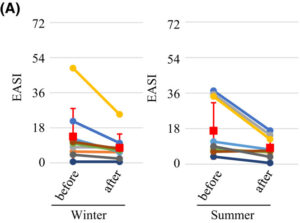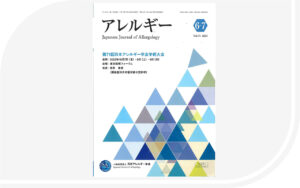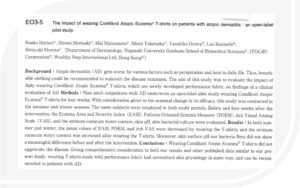RESEARCH COLLABORATION WITH ACADEMIC INSITUTIONS
Journal of Cutaneous Immunology and Allergy
This study assessed the impact of wearing a specialized T-shirt, the Comfiknit Atopic Eczema® T-shirt, on atopic dermatitis (AD) patients during summer and winter. Ten adults with AD participated in a 4-week open-label pilot study during each season. Results showed improvements in AD symptoms, including reduced Eczema Area and Severity Index (EASI), Patient-Oriented Eczema Measure (POEM), and itch Visual Analogue Scale (VAS) scores. The T-shirt increased stratum corneum water content (SCWC) without affecting skin pH or bacterial cultures. Overall, wearing these T-shirts helped prevent AD exacerbation year-round, suggesting they may contribute to skin homeostasis.
Approval of the research protocol: This study was approved by the ethics committee of the Clinical Research Review Board of Nagasaki University (Reference number: 20101902).
https://onlinelibrary.wiley.com/doi/full/10.1002/cia2.12316
Massachusetts Institute of Technology (MIT), United States
Comfiknit and Massachusetts Institute of Technology (MIT) have commenced a three-years collaborative research project from January 2024.
The collaboration will aim to develop innovative strategies and design principles for optimizing heat transfer in athletic garments for athletic performance and body temperature homeostasis. The results of the collaborative research is expected to develop mathematical models to explore the design space of athletic garments that could help industry develop standards of a genuine sweat-wicking and heat stroke proof running tee.
The research will primarily focus on enhancing athletic performance and mitigating the risk of sports injuries, especially heat exhaustion, during endurance sporting events.
https://markets.ft.com/data/announce/detail?dockey=600-202401230800DGAP____ASPR_____corporate_1821225_en-1
Nagasaki University, Japan
Extracted from Japanese Journal of Allergology Vol. 71 2022, p. 735
The Graduate School of Biomedical Sciences at Nagasaki University has recently published an academic paper recommending Comfiknit functional T-shirt for people suffering from a common but chronic skin condition called atopic dermatitis (AD).
Co-authored by several professors from the Department of Dermatology at Nagasaki University, the paper was presented at the 71st Annual Meeting of the Japanese Society of Allergology on Oct 7-9, 2022.
The release of the publication followed a clinical trial of nine AD patients wearing specially-designed T-shirts (Comfiknit Atopic Eczema T-shirts) over a total of eight weeks in the summer and winter seasons in 2020. (Ref. Japanese Journal of Allergology Vol. 71 2022, p. 735)
Hong Kong Education University
The effect of sportswear composition and layer structure on physiological response and comfort Wing Shan CHAN1, 2, Kenneth LAU2 and Daniel Hung Kay CHOW1
1 Department of Health & Physical Education, The Education University of Hong Kong
2 Wealthy Step International Ltd., Hong Kong
The purpose of this research is to compare the impact of two sportswear samples with different fabric composition and layer structure on physiological changes and perceived comfort. Sample 1 is a 2-layer structured fabric made from 100% polyester of a leading sportswear brand. Sample 2 is Comfiknit fabric, a blended mixture (polyester, modal and spandex), a 3-layer structured fabric.
Conclusion
The effects of sportswear composition and fabric layer structure on athletes’ physiological change and perceived comfort were examined. Our results suggested that fabric composition and layer structure affect wearing comfort, and that comfort measure is observed to be more sensitive to the differences in material use and layer structure design. Sample 2, the three-layer blended mixture fabric resulted in better comfortability possibly due to improved moisture transportation and absorption as reported in past study. The presence of regenerated fibre in a 3-layer structure appears to be the differential factor distinguishing the sportswear in subjective comfort ratings in this study. Furthermore, standardising data collection with a larger sample size can improve the accuracy and power of the study. It is recommended to further investigate the effect of layers in fabric structure on wearing comfort.
- Privacy Policy
- © 2023




